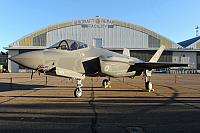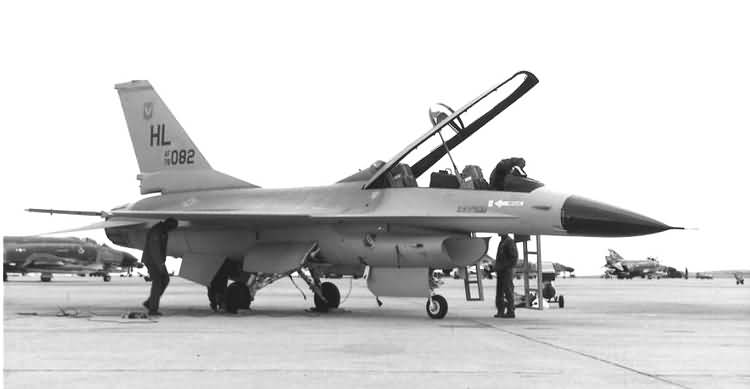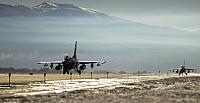Fighter Jet News
F-16 Fighting Falcon News
Hill AFB to begin transition from F-16 to F-35
March 17, 2014 (by
Lieven Dewitte) -
As Hill Air Force Base readies for the arrival of a new fleet of F-35s, they are preparing to phase out its mainstay aircraft, the F-16 Fighting Falcon. Before the farewell actually happens, both jets will be in simultaneous operation at the base.
Hill, located in northern Utah, is set to receive the first operational squadron of F-35 Lightning II jets sometime next year. Ultimately, the base is projected to receive 72 F-35As, which will be spread among three fighter squadrons.
Once they start to arrive, preparations will begin to send the 48 F-16s currently assigned to Hill, out the door.
Base spokesman George Jozens said the base is preparing for the new aircraft by building a $13.5 million hangar to house the jets. There will also be a handful of other construction projects to prepare for the arrival, he said.
It will also require some equipment upgrades and new training for operations and maintenance personnel, he said.
The Air Force in December selected Hill to serve as an operational base for the new F-35.
The F-16's departure from the base will be significant, as the jet has had a long and notable history with Hill. On 1 January 1979, the 16th Tactical Fighter Training Squadron, "First in the F-16", was relocated at Hill AFB, Utah as part of the 388th Tactical Fighter Wing. From 1 January 1979 through 31 March 1983 the 16 TFTS was the first RTU for the F-16 and acted as a worldwide RTU, training over 240 pilots in the F-16.
The 4th TFS 'Fightin' Fujins', was the first USAF squadron to achieve Initial Operational Capability (IOC) on November 12th, 1980. In March of 1981, the 4th TFS took twelve of its F-16s to Norway for a month-long deployment, marking the first deployment of the USAF F-16s overseas.
In May 1989, the first F-16C block 40 aircraft arrived at Hill AFB, Utah. The new model F-16, designed to accommodate the Low Altitude Navigation and Targeting Infrared for Night (LANTIRN) pod.
The 388th TFW was the first unit to fly LANTIRN-equipped F-16s into conflict over the skies of Iraq and Kuwait during Operations Desert Shield and Desert Storm.
In the 35-plus years at Hill, the F-16 has been deployed to the Persian Gulf in support of Operation Desert Storm, been a major factor in the global war on terror in wars in Afghanistan and Iraq, and served countless other missions.
For more than 30 years, the base had 72 F-16s spread among three squadrons until an Air Force restructuring in 2010, when one squadron was deactivated and Hill lost 24 jets.
Many of the Vipers will be reassigned within the Department of Defense bu at this point it is unknown where Hill's final 48 F-16s will end up when they leave the base.
There’s optimism that landing the F-35 will insulate Hill from future defense budget cuts. The F-35 could very well give Hill AFB a mission for decades to come, much like the F-16 did when it arrived in 1979.
For details on the history and operations of the Units part of the 388 Fighter Wing:
Once they start to arrive, preparations will begin to send the 48 F-16s currently assigned to Hill, out the door.
Base spokesman George Jozens said the base is preparing for the new aircraft by building a $13.5 million hangar to house the jets. There will also be a handful of other construction projects to prepare for the arrival, he said.
It will also require some equipment upgrades and new training for operations and maintenance personnel, he said.
The Air Force in December selected Hill to serve as an operational base for the new F-35.
The F-16's departure from the base will be significant, as the jet has had a long and notable history with Hill. On 1 January 1979, the 16th Tactical Fighter Training Squadron, "First in the F-16", was relocated at Hill AFB, Utah as part of the 388th Tactical Fighter Wing. From 1 January 1979 through 31 March 1983 the 16 TFTS was the first RTU for the F-16 and acted as a worldwide RTU, training over 240 pilots in the F-16.
The 4th TFS 'Fightin' Fujins', was the first USAF squadron to achieve Initial Operational Capability (IOC) on November 12th, 1980. In March of 1981, the 4th TFS took twelve of its F-16s to Norway for a month-long deployment, marking the first deployment of the USAF F-16s overseas.
In May 1989, the first F-16C block 40 aircraft arrived at Hill AFB, Utah. The new model F-16, designed to accommodate the Low Altitude Navigation and Targeting Infrared for Night (LANTIRN) pod.
The 388th TFW was the first unit to fly LANTIRN-equipped F-16s into conflict over the skies of Iraq and Kuwait during Operations Desert Shield and Desert Storm.
In the 35-plus years at Hill, the F-16 has been deployed to the Persian Gulf in support of Operation Desert Storm, been a major factor in the global war on terror in wars in Afghanistan and Iraq, and served countless other missions.
For more than 30 years, the base had 72 F-16s spread among three squadrons until an Air Force restructuring in 2010, when one squadron was deactivated and Hill lost 24 jets.
Many of the Vipers will be reassigned within the Department of Defense bu at this point it is unknown where Hill's final 48 F-16s will end up when they leave the base.
There’s optimism that landing the F-35 will insulate Hill from future defense budget cuts. The F-35 could very well give Hill AFB a mission for decades to come, much like the F-16 did when it arrived in 1979.
For details on the history and operations of the Units part of the 388 Fighter Wing:
Additional images:

The first F-35A Lightning II to arrive at Hill AFB sits on display in front of a hangar the morning of September 20th, 2013. Hill, Lockheed Martin and Utah elected officials and community members gathered for a ceremony to commemorate the beginning of F-35 depot maintenance at Hill AFB. [USAF photo by Alex R. Lloyd]
Related articles:
Forum discussion:
Tags
- Hill AFB may lose some F-16s (2009-05-20)
- F-16 fires on SUV while training at Utah Test and Training Range (2008-04-15)
- Hill's 388th and 419th Fighter Wings share F-16s (2007-04-26)
- F-35 News: First ANG base to host the F-35A Lightning IIs (2013-12-17)
- F-16 Fighting Falcon news archive
Forum discussion:
- Start a discussion about this article in the F-16.net forum.
Tags


